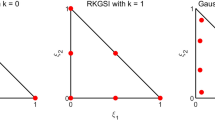Abstract
In this paper we present the concept of singularly perturbed vector field (SPVF) method, and its application to thermal explosion of diesel spray combustion. Given a system of governing equations, which consist of hidden Multi-scale variables, the SPVF method transfer and decompose such system to fast and slow singularly perturbed subsystems. The resulting subsystem enables us to understand better the complex system, and to simplify the calculations. Later powerful analytical, numerical and asymptotic methods [e.g method of integral (invariant) manifold, the homotopy analysis method etc.] can be applied to each subsystem. In this paper, we compare the results obtained by the methods of integral invariant manifold and SPVF as applied to the spray droplets combustion model.












Similar content being viewed by others
Abbreviations
- A :
-
Pre-exponential factor (1 / s)
- B :
-
Universal gas constant (\(J k mol^{-1} K^{-1}\))
- C :
-
Molar concentration (\(k mol m^{-3}\))
- c :
-
Specific heat capacity (\(Jkg^{-1}K^{-1}\))
- E :
-
Activation energy (\(J k mol^{-1}\))
- L :
-
Liquid evaporation energy (i.e., latent heat of evaporation, Enthalpy of evaporation) (\(Jkg^{-1}\))
- m :
-
Different size of droplets’ radii
- n :
-
Number of droplets per unit volume (\(m^{-3}\))
- Q :
-
Combustion energy (\(J kg^{-1}\))
- R :
-
Radius of droplet (m)
- T :
-
Temperature (K)
- t :
-
Time (s)
- d :
-
Liquid fuel droplets
- f :
-
Combustible gas component of the mixture
- g :
-
Gas mixture
- p :
-
Under constant pressure
- 0:
-
Initial state
References
Gol’dshtein, V.M., Sobolev, V.A.: Singularity theory and some problems of functional analysis. Am. Math. Soc. 153(2), 73–92 (1992)
Babushok, V.I., Gol’dshtein, V.M.: Structure of the thermal explosion limit. Combust. Flame 72(3), 221–226 (1988)
McIntosh, A.C., Gol’dshtein, V.M., Goldfarb, I., Zinoviev, A.: Thermal explosion in a combustible gas containing fuel droplets. Combust. Theory Model. 2(2), 153–165 (1998)
Goldfarb, I., Gol’dshtein, V.M., Kuzmenko, G., Greenberg, B.J.: Monodisperse spray effects on thermal explosion in a gas. In: HTD-352 Proc. ASME Heat Transfer Division, ASME Int. Congress and Exposition, Dallas, TX, vol. 2, pp. 199–206 (1997)
Roussel, M.R., Fraser, S.J.: Geometry of the steady-state approximation: perturbation and accelerated convergence methods. J. Chem. Phys. 93, 47–63 (1990)
Roussel, M.R., Fraser, S.J.: Accurate steady-state approximations: implications for kinetics experiments and mechanism. J. Chem. Phys. 95, 8762–8770 (1991)
Roussel, M.R., Fraser, S.J.: Global analysis of enzyme inhibition kinetics. J. Chem. Phys. 97, 8316–8327 (1993)
Roussel, M.R., Fraser, S.J.: Invariant manifold methods for metabolic model reduction. Chaos 11, 196–206 (2001)
Zagaris, A., Kaper, H.G., Kaper, T.J.: Analysis of the computational singular perturbation reduction method for chemical kinetics. J. Nonlinear Sci. 14, 59–91 (2004)
Zagaris, A., Kaper, H.G., Kaper, T.J.: Fast and slow dynamics for the computational singular perturbation method. Soc. Ind. Appl. Math. 2(4), 613–638 (2004)
Berglunda, N., Gentzd, B.: Geometric singular perturbation theory for stochastic differential equations. J. Diff. Equ. 191(1), 1–54 (2003)
Fenichel, N.: Geometric singular perturbation theory for ordinary differential equations. J. Diff. Equ. 31(1), 53–98 (1979)
Jones, C.K.: Geometric singular perturbation theory. Dynamical Systems, 1609 of the series Lecture Notes in Mathematics, pp 44–118 (2006)
Maas, U., Pope, S.B.: Implementation of simplified chemical kinetics based on intrinsic low-dimensional manifolds (PDF). In: Symposium (International) on Combustion. Twenty-Fourth Symposium on Combustion vol. 24(1), pp. 103–112 (1992)
Maas, U., Pope, S.B.: Simplifying chemical kinetics: intrinsic low-dimensional manifolds in composition space. Combust. Flame 88(3–4), 239–264 (1992)
Bongers, H., Van Oijen, J.A., De Goey, L.P.H.: Intrinsic low-dimensional manifold method extended with diffusion. Proc. Combust. Inst. 29(1), 1371–1378 (2002)
Alison, S.T., Whitehouse, L., Richard, L.: The estimation of intrinsic low dimensional manifold dimension in atmospheric chemical reaction systems. In: Bruno, S. (ed.) Air Pollution Modelling and Simulation, pp. 245–263. Springer, Berlin Heidelberg (2002)
Hans, G.K., Tasso, J.K.: Asymptotic analysis of two reduction methods for systems of chemical reactions. Physica D 165, 66–93 (2002)
Bykov, V., Maas, U.: Reaction-diffusion manifolds and global quasi-linearization: two complementary methods for mechanism reduction. Open Thermodyn J 7, 92–100 (2013)
Bykov, V., Griffiths, J.F., Piazzesi, R., Sazhin, S.S., Sazhina, E.M.: The application of the global quasi-linearisation technique to the analysis of the cyclohexane/air mixture autoignition. Appl. Math. Comput. 219(14), 7338–7347 (2013)
Bykov, V., Gol’dshtein, V., Maas, U.: Simple global reduction technique based on decomposition approach. Combust. Theory Model. 12(2), 389–405 (2008)
Bykov, V., Gol’dshtein, V.: On a decomposition of motions and model reduction. J. Phys. Conf. Ser. 138, 1–15 (2008)
Bykov, V., Goldfarb, I., Gol’dshtein, V.: Singularly perturbed vector fields. J. Phys. Conf. Ser. 55, 28–44 (2006)
Bykov, V., Maas, U.: Investigation of the Hierarchical Structure of Kinetic Models in Ignition Problems. Journal Physics of Chemistry 223, 461–479 (2009)
Bykov, V., Maas, U.: Problem adapted reduced models based on Reaction-Diffusion Manifolds (REDIMs). Proc. Combust. Inst. 32(1), 561–568 (2009)
Bykov, V., Maas, U.: The extension of the ILDM concept to reaction-diffusion manifolds. Combust. Theory Model. 11(6), 839–862 (2007)
Bykov, V., Goldfarb, I., Gol’dshtein, V., Greenberg, J.B.: Auto-ignition of a polydisperse fuel spray. Proc. Combust. Inst. 31(2), 2257–2264 (2007)
Author information
Authors and Affiliations
Corresponding author
Rights and permissions
About this article
Cite this article
Nave, O. Singularly Perturbed Vector Field Method (SPVF) Applied to Combustion of Monodisperse Fuel Spray. Differ Equ Dyn Syst 27, 57–74 (2019). https://doi.org/10.1007/s12591-017-0373-7
Published:
Issue Date:
DOI: https://doi.org/10.1007/s12591-017-0373-7




